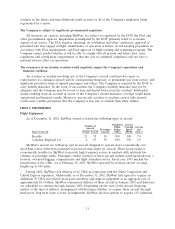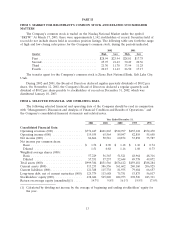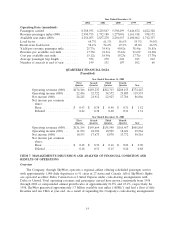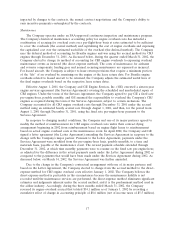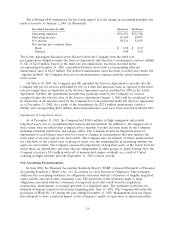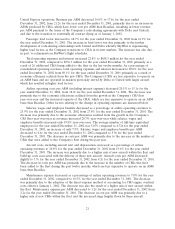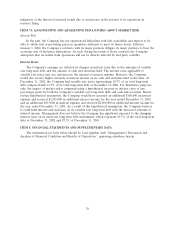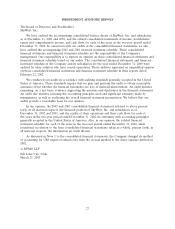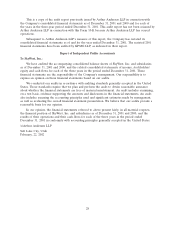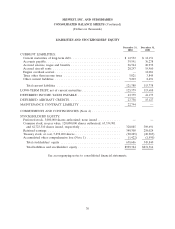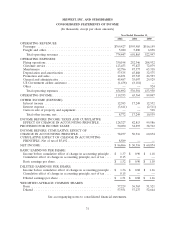SkyWest Airlines 2002 Annual Report Download - page 25
Download and view the complete annual report
Please find page 25 of the 2002 SkyWest Airlines annual report below. You can navigate through the pages in the report by either clicking on the pages listed below, or by using the keyword search tool below to find specific information within the annual report.United Express operations. Revenue per ASM decreased 16.0% to 17.8¢ for the year ended
December 31, 2002, from 21.2¢ for the year ended December 31, 2001, primarily due to an increase in
ASMs produced by CRJs, which have lower cost per ASM than Brasilias, (resulting in lower revenue
per ASM pursuant to the terms of the Company’s code-sharing agreements with Delta and United),
and due to the transition to essentially all contract flying as of January 1, 2002.
Passenger load factor increased to 68.7% for the year ended December 31, 2002 from 61.1% for
the year ended December 31, 2001. The increase in load factor was due primarily to the further
development of code-sharing relationships with United and Delta whereby SkyWest is experiencing
higher load factors as the Company transitions to CRJs in its new markets. The increase was also due,
in part, to refinements in SkyWest’s flight schedules.
Total operating expenses and interest increased 22.8% to $658.5 million for the year ended
December 31, 2002, compared to $536.3 million for the year ended December 31, 2001 primarily as a
result of 26 additional CRJs being added to the fleet in the last twelve months. As a percentage of
consolidated operating revenues, total operating expenses and interest decreased to 85.0% for the year
ended December 31, 2002 from 89.1% for the year ended December 31, 2001 primarily as a result of
economic efficiency realized from the new CRJs. The Company’s CRJs are less expensive to operate on
an ASM basis and are operated in markets previously served by Delta or United with larger aircraft
which has resulted in higher load factors.
Airline operating costs per ASM (including interest expense) decreased 20.1% to 15.1¢ for the
year ended December 31, 2002, from 18.9¢ for the year ended December 31, 2001. The decrease was
primarily due to the economic efficiencies realized from the growth in the Company’s CRJ fleet
year-over-year and the increased capacity of the CRJs, which are less expensive to operate on an ASM
basis than Brasilias. Other factors relating to the change in operating expenses are discussed below.
Salaries, wages and employee benefits decreased as a percentage of airline operating revenues to
25.9% for the year ended December 31, 2002 from 27.8% for the year ended December 31, 2001. The
decrease was primarily due to the economic efficiencies realized from the growth in the Company’s
CRJ fleet year-over-year as revenues increased 28.7% year-over-year while salaries, wages and
employee benefits increased only 19.8% year-over-year. The average number of full-time equivalent
employees for the year ended December 31, 2002 was 5,079, compared to 4,726 for the year ended
December 31, 2001, an increase of only 7.5%. Salaries, wages and employee benefits per ASM
decreased to 4.6¢ for the year ended December 31, 2002 compared to 5.9¢ for the year ended
December 31, 2001. The decrease in costs per ASM was primarily due to the increase in the number of
CRJs that were added to the Company’s fleet during the past year.
Aircraft costs, including aircraft rent and depreciation, increased as a percentage of airline
operating revenues to 20.8% for the year ended December 31, 2002 from 19.6% for the year ended
December 31, 2001. The increase was primarily due to a higher mix of new aircraft within the fleet and
build-up costs associated with the delivery of these new aircraft. Aircraft costs per ASM decreased
slightly to 3.7¢ for the year ended December 31, 2002 from 4.2¢ for the year ended December 31, 2001.
The decrease in costs per ASM was primarily due to the increase in the number of CRJs that have
been added to the fleet during the past twelve months, which are less expensive to operate on an ASM
basis than Brasilias.
Maintenance expense decreased as a percentage of airline operating revenues to 7.0% for the year
ended December 31, 2002, compared to 10.5% for the year ended December 31, 2001. The decrease
was primarily due to the adoption of the direct-expense method of accounting for CRJ engine overhaul
costs effective January 1, 2002. The decrease was also the result of a higher mix of new aircraft within
the fleet. Maintenance expense per ASM decreased to 1.2¢ for the year ended December 31, 2002 from
2.2¢ for the year ended December 31, 2001. The decrease in cost per ASM was primarily due to a
higher mix of new CRJs within the fleet and the increased stage lengths flown by these aircraft.
21


